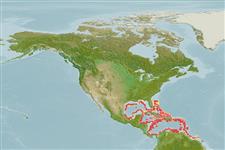Actinopterygii (ray-finned fishes) >
Gadiformes (Cods) >
Macrouridae (Grenadiers or rattails) > Macrourinae
Etymology: Nezumia: A Japanese word that means "mouse" .
Environment / Climate / Range
Ecology
Marine; bathydemersal; non-migratory; depth range 366 - 1097 m (Ref. 1371). Deep-water, preferred ?; 30°N - 4°N, 97°W - 50°W (Ref. 1371)
Western Central Atlantic: abundant in tropical waters.
Size / Weight / Age
Maturity: Lm ? range ? - ? cm
Max length : 45.0 cm TL male/unsexed; (Ref. 1371)
Dorsal
spines
(total): 2;
Anal
spines: 0. Snout short, narrow, bluntly rounded, with broad scutes at its tip and lateral angles, its underside naked. Body scales with numerous, lanceolate spinules in 8 to 10 sub parallel rows in larger specimens. Overall color is brownish black; fins blackish.
Taken as bycatch of deepwater trawl fishery for royal red shrimp of western central Atlantic.
Life cycle and mating behavior
Maturity | Reproduction | Spawning | Eggs | Fecundity | Larvae
Cohen, D.M., T. Inada, T. Iwamoto and N. Scialabba, 1990. FAO species catalogue. Vol. 10. Gadiform fishes of the world (Order Gadiformes). An annotated and illustrated catalogue of cods, hakes, grenadiers and other gadiform fishes known to date. FAO Fish. Synop. 125(10). Rome: FAO. 442 p. (Ref. 1371)
IUCN Red List Status (Ref. 115185)
CITES (Ref. 94142)
Not Evaluated
Threat to humans
Harmless
Human uses
Fisheries: minor commercial
More information
Common namesSynonymsMetabolismPredatorsEcotoxicologyReproductionMaturitySpawningFecundityEggsEgg development
Age/SizeGrowthLength-weightLength-lengthLength-frequenciesMorphometricsMorphologyLarvaeLarval dynamicsRecruitmentAbundance
ReferencesAquacultureAquaculture profileStrainsGeneticsAllele frequenciesHeritabilityDiseasesProcessingMass conversion
Tools
Can't connect to MySQL database fbquizv2. Errorcode: Too many connections
